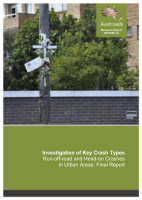Road Safety

Investigation of Key Crash Types: Run-off-road and Head-on Crashes in Urban Areas: Final Report
- Publication no: AP-R450-14
- ISBN: 978-1-925037-49-4
- Published: 24 March 2014
- PDF (free) Download
This report collates research into factors contributing to the incidence and severity of run-off-road and head-on collisions on urban roads in Australia and New Zealand. It also identifies possible measures to reduce the incidence and severity of these crashes.
Run-off-road and head-on collisions are both loss-of-control collisions that have a high-incidence and severity in urban environments.
Crash data analysis and site investigations were conducted to add to currently available research on this topic. Recommendations based on this research are made on ways to reduce the incidence and severity of these crash types, in order to achieve a Safe System.
- 1. Introduction
- 1.1. Background
- 1.2. Objectives
- 1.3. Methodology
- 1.3.1. Task 1 – Literature Review and Internet Search
- 1.3.2. Task 2 – Collection and Analysis of Crash Data
- 1.3.3. Task 3 – Site Investigations
- 2. Literature Review and Internet Search
- 2.1. Definitions for Literature Search
- 2.1.1. Urban Road
- 2.1.2. Run-off-road Crashes
- 2.1.3. Head-on Crashes
- 2.1.4. Loss-of-control Collision
- 2.2. Prevalence of Run-off-road and Head-on Crashes
- 2.3. Crash Contributory Factors
- 2.3.1. Horizontal Alignment
- 2.3.2. Roundabout Design
- 2.3.3. Poor Road Delineation
- 2.3.4. Road Surface
- 2.3.5. Poor Lighting
- 2.3.6. Poor Sight Distance
- 2.3.7. Lane Width
- 2.3.8. Weather Conditions
- 2.3.9. Medical Conditions
- 2.3.10. Driver Distraction
- 2.3.11. Fatigue
- 2.3.12. Influence of Alcohol
- 2.3.13. Driver Age
- 2.3.14. Vehicle Speed
- 2.3.15. Vehicle Kinematics
- 2.4. Crash Countermeasures
- 2.4.1. Road Design
- 2.4.2. Speed Limit
- 2.4.3. Medians
- 2.4.4. Road Surface
- 2.4.5. Sight Distance
- 2.4.6. Shoulder Rumble Strips
- 2.4.7. Centreline Rumble Strips
- 2.4.8. Signage
- 2.4.9. Drainage
- 2.4.10. Road Delineation
- 2.4.11. Roadside Hazards
- 2.4.12. Vehicle Technology and Design
- 3. Crash Data Analysis
- 3.1. Introduction
- 3.2. Results
- 3.2.1. Run-off-road (ROR) Casualty Crashes
- 3.2.2. Head-on Casualty Crashes
- 3.2.3. Casualty Crashes by Year
- 3.2.4. Casualty Crashes by Day-of-Week
- 3.2.5. Casualty Crashes by Time-of-Day
- 3.2.6. Casualty Crashes by Lighting Condition
- 3.2.7. Casualty Crashes by Weather Condition
- 3.2.8. Casualty Crashes by Speed Zone
- 3.2.9. Casualty Crashes by Vertical Road Alignment
- 3.2.10. Casualty Crashes by Horizontal Road Alignment
- 3.2.11. Casualty Crashes by Intersection Type
- 3.2.12. Casualty Crashes by Crash Type
- 3.2.13. Proportion of Run-off-road Casualty Crashes that Hit an Object
- 3.2.14. Proportion of Run-off-road Casualty Crashes that Resulted in a Vehicle Rollover
- 3.2.15. Proportion of Head-on Casualty Crashes Originating in an Overtaking Manoeuvre
- 3.2.16. Casualty Crashes by Vehicle Type
- 3.2.17. Casualty Crashes by Vehicle Age
- 3.2.18. Casualty Crashes by Controller Age
- 3.2.19. Casualty Crashes by Controller Gender
- 3.2.20. Fatal Crashes by Controller Blood Alcohol Concentration
- 3.3. Key Findings
- 3.3.1. Run-off-road Crashes
- 3.3.2. Head-on Crashes
- 4. Site Investigations
- 4.1. Assessment of Causal Factors
- 4.1.1. Site Selection
- 4.1.2. Site Inspections
- 4.2. Key Findings of the Site Investigations
- 4.2.1. Run-off-road Collisions
- 4.2.2. Head-on Collisions
- 4.3. Examples of Key Findings
- 4.3.1. Geometry
- 4.3.2. Roundabouts
- 4.3.3. Signalised Intersections
- 4.3.4. Visibility Issues
- 4.3.5. Roadside Hazards
- 5. Key Findings and Discussion
- 5.1. Humans
- 5.2. Vehicle
- 5.3. Road Environment
- 6. Conclusions and Recommendations
- 6.1. Conclusions
- 6.2. Issues for Consideration as Part of the Austroads Guides Updates
- 6.3. Further Austroads Work
- Road maintenance programs
- Capital works and road safety programs
- References
- Appendix A Site Investigations
- A.1 Sydney, New South Wales
- A.2 Brisbane, Queensland
- A.3 Melbourne, Victoria
- Appendix B Safety Checklist
- B.1 Crash Contributing Factors and Safety Check
- Appendix C Site Investigations
- Appendix D Commentary of Findings of Site Investigations
- Appendix E Crash Reduction Factors
Related publications
WEB-ZRT-24
AP-R700-23
Latest Road Safety News
